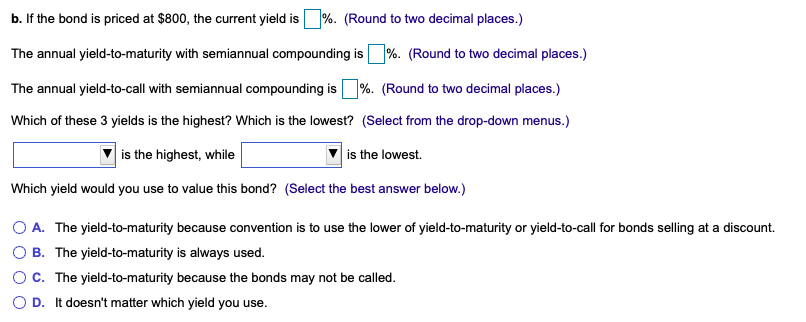

A(n) 10.5%, 25-year bond has a par value of $1,000 and a call price of $1,025. (The bond's first call date is in 5 years.) Coupon payments are made semiannually (so use semiannual compounding where appropriate). a. Find the current yield, YTM, and YTC on this issue, given that it is currently being priced in the market at $1,150. Which of these 3 yields is the highest? Which is the lowest? Which yield would you use to value this bond? Explain. b. Repeat the 3 calculations above, given that the bond is being priced at $800. Now which yield is the highest? Which is the lowest? Which yield would you use to value this bond? Explain. a. If the bond is priced at $1,150, the current yield is %. (Round to two decimal places.) The annual yield-to-maturity with semiannual compounding is %. (Round to two decimal places.) The annual yield-to-call with semiannual compounding is %. (Round to two decimal places.) Which of these 3 yields is the highest? Which is the lowest? (Select from the drop-down menus.) is the highest, while V is the lowest. Which yield would you use to value this bond? (Select the best answer below.) O A. The yield-to-call because convention is to use the lower more conservative measure of yield. O B. The yield-to-maturity is always used. O C. The yield-to-maturity because the bonds may not be called. OD. It doesn't matter which yield you use. b. If the bond is priced at $800, the current yield is %. (Round to two decimal places.) The annual yield-to-maturity with semiannual compounding is 1%. (Round to two decimal places.) The annual yield-to-call with semiannual compounding is %. (Round to two decimal places.) Which of these 3 yields is the highest? Which is the lowest? (Select from the drop-down menus.) is the highest, while is the lowest Which yield would you use to value this bond? (Select the best answer below.) O A. The yield-to-maturity because convention is to use the lower of yield-to-maturity or yield-to-call for bonds selling at a discount. O B. The yield-to-maturity is always used. OC. The yield-to-maturity because the bonds may not be called. OD. It doesn't matter which yield you use








